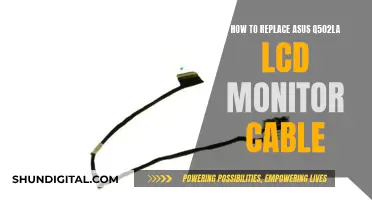
Hanging a monitor on a wall is a great way to save space on your desk. It is possible to hang a monitor on a wall with minimal hardware, and the process can be relatively inexpensive. However, it is important to be careful when drilling into walls to avoid damaging wires or pipes.
What You'll Learn

The benefits of mounting a monitor to a wall
Mounting a monitor to a wall has several benefits. Firstly, it can help you reclaim valuable desk space, especially if you have a small desk or need room for additional equipment. By freeing up desk space, you can create a more organised and efficient work environment.
Secondly, wall-mounted monitors can provide ergonomic benefits. You can position the monitor at a height and angle that reduces neck and back strain, leading to a more comfortable and productive work experience. This is especially beneficial if you spend long hours in front of the screen.
Additionally, mounting a monitor on the wall can enhance your viewing experience. You can adjust the monitor's height and angle to optimise your line of sight, reducing eye strain and improving your overall viewing comfort.
Wall-mounted monitors also offer flexibility in terms of placement. You can choose the most suitable location on the wall to mount your monitor, ensuring that it is at an optimal distance and position for your specific needs. This can be advantageous in spaces with limited desk or table options.
Lastly, mounting a monitor on the wall can give your workspace a sleek and modern aesthetic. It creates a clean and clutter-free look, especially when paired with other wall-mounted devices or decor. This can be particularly beneficial in professional settings or spaces where aesthetics are important.
Monitor Data Usage: Simple Tips for Combating Overage
You may want to see also

The tools and materials needed to mount a monitor to a wall
To mount a monitor to a wall, you will need a variety of tools and materials. The exact specifications and quantities of these items may vary depending on the type of mount and monitor you have, but here is a general list:
- Mounting hardware: This includes items like screws, washers, and anchors. Some wall mounts come with their own mounting hardware, while others require you to purchase these items separately. Make sure the screws are the appropriate size and length for your specific monitor and mount.
- Drill: You will need a drill to create holes in the wall for the mounting hardware. A cordless drill is recommended for ease of use.
- Drill bits: Various sized drill bits are needed for different steps in the process. A smaller bit is used for creating pilot holes, and a larger bit is used for enlarging the holes to accommodate anchors.
- Stud finder: An electronic stud finder will help you locate the studs in your wall, which provide a sturdy mounting surface.
- Level: A level tool, such as a water level or a bubble level, will help you ensure that your mount is straight and even.
- Pencil: Use a pencil to mark the locations for drilling on the wall.
- Monitor mount: Choose a wall mount that is compatible with your monitor. Consider the weight and size of your monitor when selecting a mount.
- Adapters: If your monitor is not VESA-compatible, you may need adapters or an aftermarket VESA plate to make it compatible with standard mounts.
- Cable: You may need a length of cable, such as uncoated cable, to create a hanging mechanism for your monitor.
- Cable clamp: A cable clamp is used to secure the cable and create a loop for hanging the monitor.
- Machine screws and washers: These are used in conjunction with the cable and cable clamp to create a secure hanging assembly.
- Weight: A small weight, such as a set of keys, can be used with a piece of string to help locate the stud and mark the drilling position.
- Screwdriver: A screwdriver and matching bits may be needed for tightening screws, depending on the type of screws used.
It is important to carefully plan and prepare before beginning the mounting process. Ensure that you have all the necessary tools and materials and that you understand the specific instructions for your monitor and mount.
Easy Guide to Installing ASUS Monitor Driver
You may want to see also

The steps to mount a monitor to a wall
Mounting a monitor to a wall can be a great way to save space and improve your viewing experience. Here is a step-by-step guide to help you through the process:
Step 1: Choose the Right Wall
Start by selecting a sturdy wall that can support the weight of your monitor. It's important to ensure that the wall you choose is strong enough to bear the weight of the monitor safely.
Step 2: Gather Tools and Materials
You will need some basic tools and materials for this project. These may include a stud finder, a level, a drill, drill bits, screws, washers, and a pencil for marking. You may also need a mounting kit or a VESA mount, depending on your monitor. Check your monitor's VESA compatibility or consider purchasing an adapter if it's not VESA compatible.
Step 3: Find a Stud
Use a stud finder to locate a stud behind the drywall. This is crucial for ensuring a secure mount. Drilling into a stud provides a sturdy anchor point for your monitor. Mark the center of the stud with a pencil.
Step 4: Mark and Drill Holes
Use a level to draw a vertical line on the wall, using the center point of the stud as a reference. Mark the holes needed for drilling. Drill the holes using a drill bit of the appropriate size, being careful to avoid any electrical wires or pipes inside the wall.
Step 5: Attach the Mounting Plate
If your monitor didn't come with a mounting plate, you may need to purchase one separately. Attach the mounting plate to the back of your monitor using the provided screws. Ensure that the length of the screws is appropriate, and use washers if necessary.
Step 6: Attach the Mount to the Wall
Securely attach the mount to the wall, making sure it's level and firmly attached. Depending on the mount, you may need to attach washers and tighten screws or bolts.
Step 7: Hang the Monitor
Carefully hang the monitor onto the mount, aligning the mounting plate with the mount on the wall. Use a bolt to secure the monitor in place. Be cautious during this step to avoid dropping the monitor.
Step 8: Adjust and Connect
Adjust the monitor's angle and position to your preferred viewing settings. Connect any necessary cables, such as power and video cables, ensuring they are neatly tucked away.
Step 9: Final Checks
Gently wiggle the monitor to ensure it is stable and securely attached to the mount. Enjoy your newly mounted monitor and the extra space you've created!
Please note that these steps are general guidelines, and the specific process may vary depending on the type of mount and monitor you are using. Always refer to the manufacturer's instructions for your particular mount and monitor model to ensure a safe and proper installation.
Asus Monitor Power Cord Length Options Explored
You may want to see also

The safety precautions to take when mounting a monitor to a wall
Mounting a monitor on a wall can be a great way to save space and improve your viewing experience. However, it is important to take several safety precautions to ensure the process is done correctly and to avoid any potential hazards. Here are some essential safety measures to follow when mounting a monitor:
Finding a Sturdy Fixture:
Before drilling any holes, ensure that you locate a sturdy fixture, such as a wall stud, to support the weight of the monitor. Drilling into a stud provides a secure mount and reduces the risk of the monitor falling. You can use a stud finder or gently tap the wall to locate the studs.
Drilling Precautions:
When drilling, use a drill bit that is smaller than the diameter of the screw you will be using. Take extra care to avoid damaging wires or other utilities behind the wall. Drilling into electrical wiring can lead to serious hazards, including fires. Always cut power to the outlet or switch you are drilling near and proceed with caution.
Weight Distribution:
Check the weight limit of the wall mount to ensure it can safely support your monitor. Distribute the weight across multiple studs or use anchors for additional support if necessary, especially for heavier monitors. This will help maintain stability and prevent damage to the wall.
Cable Management:
Secure all cables and cords properly to prevent tripping hazards and to ensure a neat and organised appearance. Use cable management solutions such as cable clips, sleeves, or wall-mounted cable covers to route and secure the cables neatly. This is especially important if you have young children or pets who may be tempted to play with loose wires.
Viewing Angle and Height:
Consider the optimal viewing angle and height for your mounted monitor. Place the monitor at eye level to maintain a natural and comfortable posture, reducing the risk of neck strain and eye fatigue. If mounting a baby monitor, ensure it is placed at a safe distance, out of reach, and providing a clear view of the desired area.
Follow Manufacturer Instructions:
Always refer to the manufacturer's instructions and guidelines for specific weight distribution requirements, mounting procedures, and safety precautions. Different monitors and mounts may have unique specifications, so it is important to follow the provided instructions carefully.
By following these safety precautions, you can ensure that your wall-mounted monitor is securely installed and safe for use.
Asus Monitor: Which One Do I Own?
You may want to see also

The different types of wall mounts available for monitors
There are several types of wall mounts available for monitors, each offering different features and benefits. Here are some of the most common types of wall mounts:
- Single Monitor Wall Mount: This type of mount is designed to hold a single monitor. It is usually adjustable, allowing you to tilt, swivel, and rotate the screen to achieve your ideal viewing position. Some single monitor wall mounts also offer height adjustment, ensuring optimal ergonomics.
- Dual Monitor Wall Mount: This option is ideal for those who use multiple monitors. It allows you to mount two screens on the wall, saving valuable desk space. Dual monitor wall mounts often feature full motion arms, enabling you to adjust the height, tilt, and angle of each screen independently for a customised setup.
- Full Motion Monitor Wall Mount: Full motion wall mounts offer maximum flexibility and adjustability. They are typically equipped with gas spring technology, allowing smooth and effortless adjustments. You can swivel, tilt, rotate, and adjust the height of your monitor to create a comfortable and ergonomic viewing experience.
- Articulating Arm Monitor Wall Mount: Articulating arms provide a wide range of motion and flexibility. They often feature gas springs or pneumatic mechanisms to facilitate height and angle adjustments. Articulating arms are ideal for monitors of various sizes and weights, ensuring a secure and customisable setup.
- Fixed Monitor Wall Mount: This type of mount holds the monitor firmly in one position against the wall. While it doesn't offer adjustability, it provides a sleek and low-profile installation. Fixed wall mounts are typically sturdy and have a high weight capacity, making them suitable for larger monitors.
- Custom DIY Monitor Wall Mount: For those who are handy and enjoy custom projects, a DIY monitor wall mount is an option. This involves purchasing or sourcing individual components, such as cables, screws, washers, and clamps, to create a unique mounting solution. While this approach offers customisability, it requires careful planning and execution to ensure safety.
When choosing a wall mount, it is essential to consider factors such as the size and weight of your monitor, the desired level of adjustability, and the VESA mounting hole pattern on the back of your monitor. Additionally, always refer to the manufacturer's instructions and specifications to ensure a safe and secure installation.
LCD Monitor Buying Guide: Key Considerations
You may want to see also
Frequently asked questions
First, figure out where you want the monitor to be placed and the height you want it at. Then, use a mounting plate and a water level to mark out the locations where you need to drill into the wall. Make sure to avoid electrical cables and pipes. Next, drill into the wall and attach the mounting plate to the back of the monitor. Finally, hang the monitor and enjoy your new setup!
You will need a TV mount, a mounting plate, a water level, a drill, screws, washers, and a screwdriver.
Mounting a monitor to the wall can help you save space on your desk and improve your posture by allowing you to position the monitor at a height that is comfortable for your neck and back.







